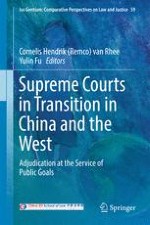2017 | OriginalPaper | Buchkapitel
The French Court of Cassation: On the Threshold of a Quiet Revolution?
verfasst von : Frédérique Ferrand
Erschienen in: Supreme Courts in Transition in China and the West
Aktivieren Sie unsere intelligente Suche, um passende Fachinhalte oder Patente zu finden.
Wählen Sie Textabschnitte aus um mit Künstlicher Intelligenz passenden Patente zu finden. powered by
Markieren Sie Textabschnitte, um KI-gestützt weitere passende Inhalte zu finden. powered by
